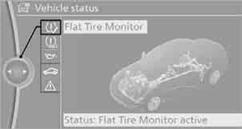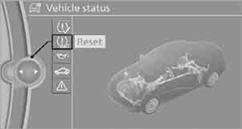Flat Tire Monitor FTM
The concept
The system does not measure the actual inflation pressure in the tires.
The system detects a pressure loss in a tire by comparing the rotational speeds of the individual wheels while moving.
In the event of a pressure loss, the diameter and therefore the rotational speed of the corresponding wheel change. This is detected and reported as a flat tire.
Functional requirementThe system must have been initialized while the tire inflation pressure was correct; otherwise, reliable signaling of a flat tire is not ensured.
Each time a tire inflation pressure has been corrected or a wheel or tire has been changed, reinitialize the system.
System limitations Sudden serious tire damage caused by external
influences cannot be indicated in advance.
Sudden serious tire damage caused by external
influences cannot be indicated in advance.
The system will not detect a natural, uniform pressure loss in all four tires. Therefore, check the tire inflation pressure regularly.
In the following situations, the system could be delayed or malfunction:
> System has not been initialized
> Driving on snowy or slippery road surface
> Performance-oriented style of driving: slip in the drive wheels, high lateral
acceleration
> Driving with snow chains
The current status of the Flat Tire Monitor can be displayed on the Control Display, e.g. whether or not the FTM is active.
1. "Vehicle Info"
2. "Vehicle status"
3. "Flat Tire Monitor"

The status is displayed.
InitializationThe initialization process adopts the set inflation tire pressures as reference values for the detection of a flat tire. Initialization is started by confirming the inflation pressures.
Do not initialize the system when driving with snow chains.
1. "Vehicle Info"
2. "Vehicle status"
3. "Reset"

4. Start the engine – do not drive away.
5. Start the initialization by selecting "Reset".
6. Start driving.
 The initialization is completed during driving,
which can be interrupted at any time.
The initialization is completed during driving,
which can be interrupted at any time.
When driving resumes, the initialization is continued automatically.
Indication of a flat tire The warning lamps come on in yellow and red.
A message appears on the Control Display. In addition, a signal sounds. There is
a flat tire or a major loss in tire pressure.
The warning lamps come on in yellow and red.
A message appears on the Control Display. In addition, a signal sounds. There is
a flat tire or a major loss in tire pressure.
1. Reduce speed and stop the vehicle with caution. Avoid sudden braking and steering maneuvers.
 If the vehicle is not equipped with run-flat
tires, do not continue driving; continuing to drive can result in serious accidents.
If the vehicle is not equipped with run-flat
tires, do not continue driving; continuing to drive can result in serious accidents.
When a flat tire is reported, the Dynamic Stability Control DSC is activated.
Actions in the event of a flat tireRun-flat tires
With a damaged tire, is possible to continue driving at speeds of up to 50 mph/80 km/h.
When driving with a damaged tire:
1. Avoid sudden braking and steering maneuvers.
2. Do not exceed a speed of 50 mph/80 km/h.
3. At the next opportunity, check the inflation pressure in all four tires.
If the inflation pressure in all four tires is correct, the Flat Tire Monitor might not have been initialized. The system must then be initialized.
Possible driving distance with complete loss of tire pressure:
The distance it is possible to drive with a flat tire depends on the load and the stress on the vehicle while driving.
With an average load, it may be possible to drive for approx. 50 miles/80 km.
When driving with damaged tires, the handling characteristics change, e.g. the vehicle will skid sooner when braking, braking distances will be longer, or self-steering response will change. Adapt your driving style accordingly. Avoid turning abruptly and driving over obstacles such as curbs, potholes, etc.
Since the possible driving distance depends to a considerable degree on the strain exerted on the vehicle while driving, it can be shorter or, with a gentle driving style, can also be longer, depending on the speed, road condition, outside temperature, vehicle load, etc.
 Drive cautiously and do not exceed a speed of
50 mph/80 km/h.
Drive cautiously and do not exceed a speed of
50 mph/80 km/h.
When there is a tire pressure loss, the handling characteristics change, e.g. there will be reduced directional stability during braking, braking distances will be longer, and self-steering response will change.
 Vibrations or loud noises while driving can
indicate final failure of the tire. Reduce your speed and bring the vehicle to a
stop; otherwise, tire components may become detached, which could result in an accident.
Do not continue driving; instead, contact your BMW center.
Vibrations or loud noises while driving can
indicate final failure of the tire. Reduce your speed and bring the vehicle to a
stop; otherwise, tire components may become detached, which could result in an accident.
Do not continue driving; instead, contact your BMW center.
See also:
External devices
General information
External audio and video devices and digital
cameras can be connected to cinch sockets, on the CD/DVD player. Operation
takes place on the external device.
Due to the large n ...
BMW TwinPower Turbo technology in the new four-cylinder engine
This new engine is the most powerful in a new generation of four-cylinder
petrol units based on the same reduced-friction core engine, their different
output ratings being achieved principally by ...
Switching on/off manually
Press the button.
On: the LED lights up.
Off: the LED goes out.
...
